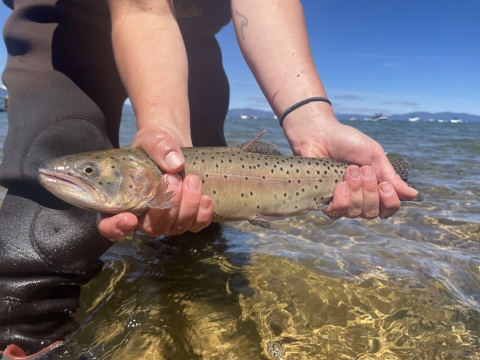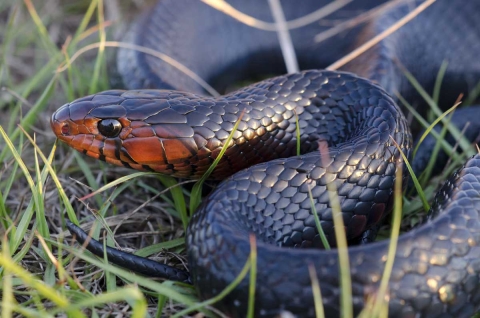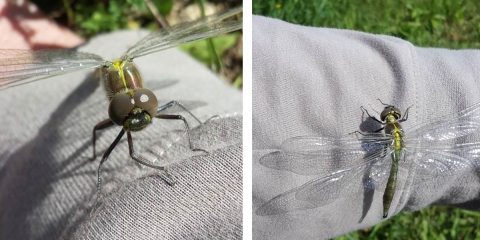Fifty years ago, facing the catastrophic loss of species across the country, the nation passed a landmark law which mobilized a generation of conservation. The Endangered Species Act was a collective commitment to protect and preserve biodiversity across the globe – for all creatures great and small. The ESA has led to the amazing recovery of iconic species like the bald eagle, whooping crane, and American Alligator. But equally as important have been the victories and advances that take place out of sight and just below the surface . . . literally. We’re talking about fish, salamanders, frogs, toads and all the critters that live in America’s freshwater streams, lakes, and rivers!
Fighting for Endangered Species – One Fish at a Time
Freshwater lakes, rivers, and wetlands are some of the most important places on the planet. But they are also in the most trouble. Freshwater ecosystems and the wild fish and animals that live in them have been harmed by habitat loss, crowded out by invasive species invasive species
An invasive species is any plant or animal that has spread or been introduced into a new area where they are, or could, cause harm to the environment, economy, or human, animal, or plant health. Their unwelcome presence can destroy ecosystems and cost millions of dollars.
Learn more about invasive species , and choked by pollution. In the United States alone, over fifty aquatic species have already been declared extinct and many others are critically endangered or threatened. The U.S. Fish and Wildlife Service’s Fish and Aquatic Conservation Program is dedicated to ensuring that freshwater species and habitats are protected for future generations. They take a unique holistic approach that includes habitat restoration through the National Fish Passage Program, a nationwide monitoring network to detect aquatic invasive species, and the National Fish Hatchery System - the largest network of captive rearing facilities in the world dedicated to species conservation.
June 10th, 2023, marks the 151th anniversary of the U.S. Fish and Wildlife Service’s National Fish Hatchery System! The National Fish Hatchery System was created to help address collapsing fisheries and boost production of food fish to feed families. Over the years, the system has evolved to meet the changing needs of conservation. Today national fish hatcheries raise 90 different species of threatened or endangered aquatic plants and animals to support recovery. And more than 20 million hatchery-raised threatened or endangered fish and wildlife are released every year into a natural setting to support wild populations.
Here’s a tour of some of the fabulous fish, magnificent mussels, tremendous tortoises, amazing amphibians, and inspiring insects being raised at national fish hatcheries across the country!
Lahontan Cutthroat Trout – The Comeback Kings
A legendary fish deserves a legendary conservation story! The Lahontan cutthroat - the only trout species native to Lake Tahoe - had completely disappeared from that ecosystem by the 1930’s and was listed under the Endangered Species Act in 1970. Now, thanks to groundbreaking work by national fish hatcheries, fish technology centers, the National Fish Passage Program and our state and Tribal partners, this iconic species is making a comeback!
Freshwater Mussels - Ecosystem Engineers
Mussels are the undisputed champions of having a name that doubles as a posh insult - Atlantic pigtoe, Carolina Heelsplitter, Texas Fatmucket! Often overlooked, sometimes considered boring, mussels are actually important to improving water quality. A healthy bed of mussels can filter over half a million gallons of water every day! Unfortunately, over 70% of the 300 species of mussels in North America have been in decline for decades. Mussels are mostly stationary, making them vulnerable to chronic pollution and sediment buildup. They also rely on host fish to complete their life cycle so dams and development that block fish migration can leave many mussels up a river without a paddle – and unable to complete their life cycle. Harrison Lake National Fish Hatchery in Virginia, like many hatcheries across the nation, raises a variety of freshwater mussel species. Working with the Virginia Department of Game and Inland Fisheries, Harrison Lake has released more than 185,000 tagged mussels in Virginia, including the endangered James spinymussel, yellow lance, and dwarf wedgemussel, as well as the threatened Atlantic pigtoe.
Eastern Indigo Snakes - Gentle Giants of the Longleaf Pine
Eastern indigo snakes are the gentle giants of the south’s longleaf pine forests - these docile snakes can reach nine feet in length and are covered in iridescent blue-black scales. While their historical range stretches from southeast Mississippi across south Alabama and Florida and up into southeast Georgia, their home has been under siege by logging, wildfire, suburban sprawl, and expanding roadways which have fragmented their forests. Welaka National Fish Hatchery, along with state wildlife agencies and conservation organizations, are raising them to help support wild populations.
Gopher Tortoise – At the Head of their Class
Sometimes we raise species to make sure they don’t become endangered. This important work can help prevent a species like the gopher tortoise avoid becoming listed in the first place! Gopher tortoise hatchlings are very vulnerable to being killed or eaten by predators in their first year, so national fish hatcheries like Warm Springs National Fish Hatchery and Natchitoches National Fish Hatchery have developed Head Start programs to raise them past that vulnerable age and then release them into protected lands to help boost the population.
Wyoming Toads - Hopping Towards Recovery
The endangered Wyoming toad was briefly presumed extinct until a population was found at Mortenson Lake National Wildlife Refuge. Now they are popping up at Saratoga National Fish Hatchery in Wyoming and Leadville National Fish Hatchery in Colorado. Specialists also outfit some of the creatures with tiny transmitters to chart their movements — toad tracking, if you will. By working with the refuge and other conservation partners, the tiny toads can be released into protected habitat to help support the wild populations.
Hine’s Emerald Dragonfly – A Buzz for Wetlands
Dragonflies play an important role in nature. They catch and eat small flying insects, including mosquitoes, biting flies, and gnats. In its immature stage (nymph), a dragonfly is an important food source for larger aquatic animals such as fish. They serve as excellent water quality watchdogs, are part of our nation's natural heritage and add beauty to our world. The Hine's emerald dragonfly was placed on the Federal Endangered Species list in 1995. The primary reason for the species' decline was loss of habitat due to urban development. Most of the wetland habitat that this dragonfly depends on for survival has been drained and filled to make way for urban and industrial development. Along with habitat restoration efforts, Genoa National Fish Hatchery in Wisconsin raises them for release into protected habitat to help support wild populations in Wisconsin and Illinois.
Investing in the Future of Conservation with Gene Banking
The National Fish Hatchery System does more than simply raise fish and wildlife to be released, they also hold important species in refugia to preserve future genetic diversity. National fish hatcheries, fish technology centers, and the national cryopreservation lab provide a buffer that protects vulnerable species against catastrophic losses or even extinction.













